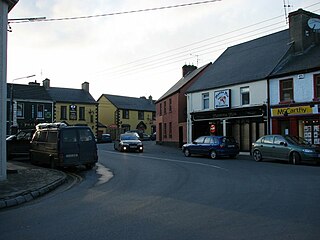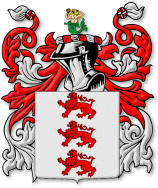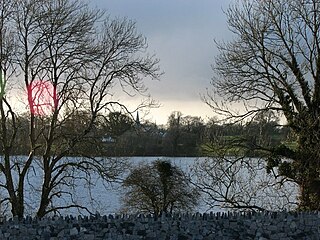
Kilfenora is a village and a civil parish in County Clare, Ireland. It is situated south of the karst limestone region known as the Burren. Since medieval times when it was the episcopal see of the Bishop of Kilfenora, it has been known as the "City of the Crosses" for its seven high crosses. The village had around 220 inhabitants in 2011. Much of the TV show Father Ted (1995–98) was filmed there.

Newmarket-on-Fergus, historically known as Corracatlin, is a town in County Clare, Ireland. It is 13 kilometres from Ennis, 8 kilometres from Shannon Airport, and 24 kilometres from Limerick.

Doora is a village and civil parish in County Clare, Ireland, just to the east of the town of Ennis.

The name McInerney is of noble Irish origin where it is found in the modern Irish form of Mac an Airchinnigh and in the old and literary forms of Mac an Oirchinnigh and Mac an Oirchindig. The pronunciation of Mac an Oirchinnigh led the name to be sometimes anglicised as McEnherheny in Irish documents from the 16th–19th centuries. The name translates to "son of the erenagh" in Irish, literally meaning "son of the Lord of church lands". Airchinneach may in turn derive from the twin components of air ("noble") and ceann ("head"), therefore meaning a 'noble-head' or 'Lord', denoting its aristocratic status in medieval Ireland. The coat of arms is three red lions passant, and the motto is Veritas, meaning "Truth". In some places, the motto can be found as Vincit Veritas, meaning "Truth Conquers", or "Truth Prevails".

Bunratty is a village in County Clare, Ireland, near Bunratty Castle. It is connected by the N18 road to Limerick and Galway. The Raite river defines the parish's eastern boundary and flows into the Shannon Estuary, which defines the southern boundary.

Dysert is a civil parish in County Clare, Ireland. The parish was formerly called Dysert O’Dea, from its having been the territory of the sept of that name. It is part of the ecclesiastical parish of Dysart and Ruan. The ruins of O'Dea Castle and a 12th-century church of Dysert O'Dea Monastery are in the townland of the same name.

Saint Conaire was an Irish holy woman who died in 530 AD. Originally from Bantry Bay in modern County Cork, she was an anchorite who lived in a self-imposed solitude and spiritual exile from society.

Kilmurry Ibrickane (Irish: Cill Mhuire Uí Bhreacáin), also known as Mullagh (Kilmurry Ibrickane), is a parish of the Roman Catholic Diocese of Killaloe that is located in west County Clare, Ireland. A civil parish of the same name also exists which is part of the historic barony of Ibrickane. The parish derives its name from the tiny settlement of Kilmurry in Ibrickane, the location of the church before Cromwellian times.

Kilnasoolagh is a civil parish in County Clare, Ireland, and a townland within that parish. Church records mention the parish in 1256.
Tomfinlough is a civil parish in County Clare, Ireland. A Christian establishment was first made here around 540 AD. The parish lands were often raided by Irish, Viking, Norman and English forces in the years that followed. The church was allowed to fall into ruins during the period when the Catholic Church was penalized in Ireland.
Clonloghan is a civil parish of County Clare, Ireland, located 21.7 kilometres (13.5 mi) by road northwest of Limerick, just north of Shannon.
Bunratty Lower is a barony in County Clare, Ireland. This ancient unit of land division is in turn divided into fourteen civil parishes.
Drumline is a civil parish of County Clare, Ireland, located about 20 kilometres (12 mi) northwest of Limerick, just north of Shannon.
Kilconry is a civil parish of County Clare, Ireland, located about 25 kilometres (16 mi) northwest of Limerick, west of Shannon on the estuary of the River Shannon. The main village in the area is Ballycalla/Ballcally and it contains the Shannon Golf Course and Shannon Airport.
Doora-Barefield is a parish in County Clare and part of the Abbey grouping of parishes within the Roman Catholic Diocese of Killaloe. It lies to the north and east of the town of Ennis and includes the suburb of Roslevan in the eastern part of Ennis.
Bodyke, also known as Kilnoe and Tuamgraney, is a parish in County Clare. It is part of the Inis Cealtra grouping of parishes within the Roman Catholic Diocese of Killaloe. It is an amalgamation of parts of the mediaeval parishes of Tomgraney (Tuamgraney) and Kilnoe.
Shannon, officially - but largely unused - St. Senan's Parish, is a parish in County Clare and part of the Tradaree grouping of parishes within the Roman Catholic Diocese of Killaloe. It is a split off of the parish of Newmarket-on-Fergus
Cross, also named Cross (Kilballyowen) is a parish in County Clare and part of the Cois Fharraige grouping of parishes within the Roman Catholic Diocese of Killaloe.

The Diocese of Tuam, Limerick and Killaloe is a diocese of the Church of Ireland that is located in the west of Ireland. The diocese was formed by a merger of the former Diocese of Tuam, Killala and Achonry and the former Diocese of Limerick and Killaloe in 2022, after the retirement of the separate dioceses' bishops and the appointment of Michael Burrows as bishop of the united diocese. It is in the ecclesiastical province of Dublin. It is one of the eleven Church of Ireland dioceses that cover the whole of Ireland. The largest diocese by area in the Church of Ireland, it covers all of counties Clare, Galway, Kerry, Limerick and Mayo, plus parts of counties Cork, Sligo, Roscommon, Offaly, Laois and Tipperary.
Ennis is a parish in County Clare and part of the Abbey grouping of parishes within the Roman Catholic Diocese of Killaloe.










